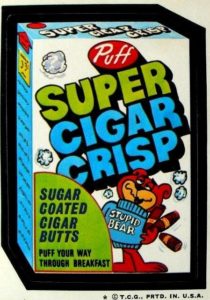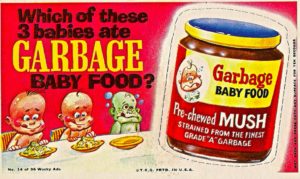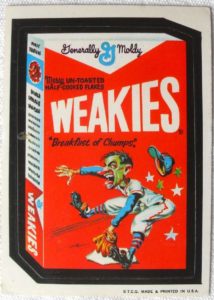
Many of the memories that are dredged up here span multiple generations. For example, Leave It to Beaver first rang with the elder Boomers as a Saturday night prime time show. Every single generation that has come since then has watched it as daily reruns.
Today’s reminiscence will hit home with us younger Boomers who grew up in the 60’s, as well as Gen X’ers, Gen Y’ers, and kids born in the 21st century.
Wacky Packages first appeared in 1967. Trading cards were a big hit back then, but this was a new idea altogether. Wacky Packages depended entirely on the concept of the pun. Familiar household products received a roasting, depicted in recognizable form, but with bizarre twists. The one Package that I recall is Tied detergent.
Another different concept about them was that they weren’t really trading cards, they were stickers. That ensured that they would liberally cover our Pee-Chees, three-ring binders, and whatever other notebooks we carried to school.
And there was one other thing. Cutups LOVED them.
Topps was the father of Wacky Packages. The baseball card manufacturers put some serious talent to work creating the lampoons. They hired a talented team of cartoonists, including Bill Griffith (Zippy), George Evans (EC comics, National Lampoon, Classics Illustrated), and Jay Lynch (lots of underground comix). Quoting from Wikipedia, here’s Lynch’s account of how things went at Wacky Packages:

I would get a phone call from Len Brown or Art Spiegelman telling me it was time for me to do some roughs for a new series of Wacky Packages. I would usually submit a dozen roughs at a time. Len would tell me, usually on the phone, which food conglomerates I could not parody, based on cease and desist letters from prior series. I had a master list of taboo companies — and this would be added to, by phone, until a new master list would be compiled and sent to me. In those days I had a pretty good working knowledge of who made what, though. So I would give Len a verbal list of maybe 20 or so products, of which he would pick a dozen. Sometimes he would suggest products, sometimes he would come up with the gag title on the phone, and I would add to it on the rough. Sometimes Spiegelman, or Bhob Stewart, or Woody Gelman would phone the assignment to me. In the 80s, Mark Newgarden would phone the assignment to me. In the 90s Ira Friedman would phone the assignment to me. But mostly it would be Len. I think in the 60s I got $8 a rough. By the 70s it had gone up to $20 a rough. By the 80s it was $125 a rough, and so on. What I got for a rough always remained the same amount in actual buying power. It has gone up with inflation, though. One rough pays about the same as a week’s worth of groceries. Always has — and always will. Anyway — after I had some idea of the initial dozen products that I would parody, I would go to the supermarket and buy these products. Sometimes I would get ideas for additional products as well — and Topps would reimburse me for this cost of the actual products when I would send them the receipt along with my bill, which I would enclose with each batch of roughs. These roughs were done in India ink and colored with Magic Markers. I would just send them in by regular mail, and I didn’t bother to retain Xerox copies of them until the mid-1970s when the drugstore down the block from my house installed a pay Xerox machine. I was living in Chicago then. I would only go to Brooklyn to meet with the Topps guys once every six months or so. Usually this was to work on a vast variety of other Topps and Bazooka projects. Wacky Packages was just one of the countless series in development then, only one in ten of which would ever see the light of day.

So, the money wasn’t huge, but it lured genius nonetheless. It also shows that there have always been companies run by insecure, humorless morons who don’t see the value of free publicity.
The Wacky Packages I remember ran for two years, followed in 1969 by Wacky Ads, whose stickers were more like billboards.
The thing about Wacky Packages is that they are universally loved by kids of every generation, therefore they keep making comebacks. The first was in 1973. Sixteen series of about 30 cards each were produced between 73 and 76, then reissued from 79 to 80.
More new series were produced in 1985 and 1991. A revamped set of series began in 2004 and ran until 2007. The most recent new series was released in this year of 2010. Thus, there has not been a generation since us Boomers who haven’t enjoyed Wacky Packages. The 21st century series are notable for the return of Jay Lynch, who had parted ways. More underground comix artists were also hired, and truists say that the most recent products have the genius of the earliest releases.
Besides school folders, Wacky Packages have also made their way onto T-shirts, and we’re not talking throwaways here. These are top-quality tees sold at the likes of Bloomingdale’s. And, if you’re so inclined, you can get massive Packages to hang on your wall.
Don’t you love it when an idea proves timeless enough to stick around forever? So far, Wacky Packages have passed this test.